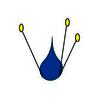| Class: | gymnosperms |
| Order: | Gnetales |
| Family: | Ephedraceae |
| Genus: | Ephedra |
| Scientific name: | Ephedra pseudodistachya Pachom. |
| Name acc. to: | Freitag & Maier-Stolte edited for FloraGREIF April 2009checked |
| Herbar: | list records   |
| Description: | Up to 20(40) cm tall. Twigs often contorted, 1 -1.1 mm wide, papillose. Leaves 1.5(2) - 2.5(3) mm, fused for 1/2 - 2/3, sheaths bulging and dark brown at base. Female cones 2-seeded, inner bracts fused for ca. 1/2, micropyle 0.7 -1.2 mm, erect. |
| Confuse with: | E. dahurica |
| Comments: | In earlier accounts E. pseudodistachya was named either E. distachya L. or E. sinica var. pumila Florin. |
| Link to Flora of China: | http://www.efloras.org/browse.aspx?flora_id=2&name_str=Ephedra |
| Habitat: | Skeletal soils in mountain steppes (Freitag & Maier-Stolte edited for FloraGREIF April 2009) |
| Habit (i)general appearance of a plant | |
| Growth form: (i)Herb, shrub, tree or climber. | shrub, subshrub or semishrub (i)Shrub, multi-stemmed, mostly (0.2) 0.5 - 5 m high, shoots woody up to the tip
example: Caragana leucophloea   inherited by genus Ephedra: shrub, subshrub or semishrub inherited by genus Ephedra: shrub, subshrub or semishrub
|
| Parasite status: (i)Is the plant a half- or full parasite? | no parasite/saprophyte (i)Plant fully autonomous, leaves with chlorophyll
example: Most plants, Ranunculus  inherited by vasc. plants: no parasite/saprophyte inherited by vasc. plants: no parasite/saprophyte
|
| Water or terrestrial plant: (i)Where do the plants grow? | terrestrial (i)Plant grows on dry land
example: Orostachys spinosa  inherited by vasc. plants: terrestrial inherited by vasc. plants: terrestrial
|
| Leaf (i)expanded, usually photosynthetic organ of a plant (including phylloclades) | |
| Leaf development: (i)Structure and development of leaves. | with green leaves (i)Plant with green leaves  inherited by vasc. plants: with green leaves inherited by vasc. plants: with green leaves
without green leaves (i)Plant at flowering time (some geophytes) or over its whole life (many parasites) with reduced leaves without chlorophyll
example: Colchicum, Cuscuta, a lot of parasites  inherited by family Ephedraceae: without green leaves inherited by family Ephedraceae: without green leaves
needles or scales (i)Leaves short, broad more or less adjacent to axis (scales)) or acicular (needles)
example: Pinus (needles), Cupressus, Ephedra (scales)   inherited by vasc. plants: needles or scales inherited by vasc. plants: needles or scales
|
| Leaf arrangement: (i)Arrangement of leaves at the stem. | opposite, opposite-decussate (i)Two leaves per node
example: Lamiaceae, e.g. Phlomis    inherited by family Ephedraceae: opposite, opposite-decussate inherited by family Ephedraceae: opposite, opposite-decussate
|
| Flower (i)reproductive portion of the plant, consisting of sepals, petals, stamens, and pistils | |
| Perianth arrangement: (i)Attention: in some plants, flowers may be dimorphic in different ways (dioecious or gynodioecious). If flowers vary, record the characters of the most showy flowers. | absent or strongly reduced (i)No perianth leaves ensheathing stamen and/or carpels
example: Callitriche   inherited by vasc. plants: absent or strongly reduced inherited by vasc. plants: absent or strongly reduced
|
| Ovary position: (i)For entirely or partly fused carpels, describe their position in relation to the insertion point of perianth leaves (best done by doing a longitudinal section of a flower). | absent (i)Without ovary: male flowers  inherited by order Gnetales: absent inherited by order Gnetales: absent
|
| Sex: (i)Distribution of male and female organs among flowers, only most commonly cases. | unisexual (i)
example: Rhodiola  inherited by vasc. plants: unisexual inherited by vasc. plants: unisexual  inherited by genus Ephedra: unisexual inherited by genus Ephedra: unisexual
dioecious (i)Male and female flowers at different individuals
example: Antennaria  inherited by genus Ephedra: dioecious inherited by genus Ephedra: dioecious
|
| Inflorescence (i)flowering part of a plant, describes the arrangement of the flowers on the flowering axis | |
| Inflorescence type: (i)Types of inflorescence. Attention: We here ask for the botanical nomenclature of inflorescences, which is sufficiently complicated. Tick only, if you are certain, or tick all inflorescence types that appear similar of these of the plant in question. | Cone (i)Flowers densely arranged along a short, often thickened axis, looking towards all sides
example: Pinus, Ephedra   inherited by vasc. plants: Cone inherited by vasc. plants: Cone
|
| Fruit (i)the seed bearing organ, with or without adnate parts; a ripened ovary and any other structures which are attached and ripen with it. Aggregate fruits are handled like simple fruits for determination. | |
| Type of fruit: (i)Common fruit types (including pseudocarp). | cone (i)No fruit, but often considered as fruit
example: Pinaceae, Cupressaceae, Ephedraceae   inherited by vasc. plants: cone inherited by vasc. plants: cone
Pseudofruit (i)Special types of diaspores, often no real fruits  inherited by vasc. plants: Pseudofruit inherited by vasc. plants: Pseudofruit
|